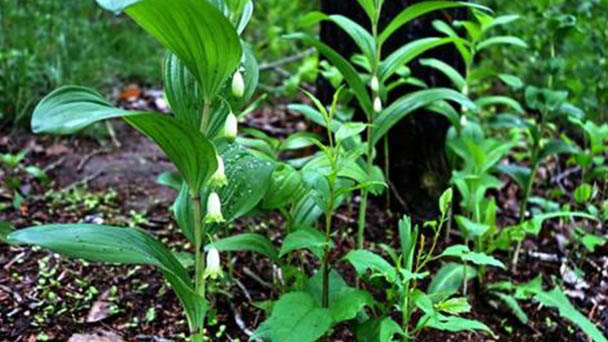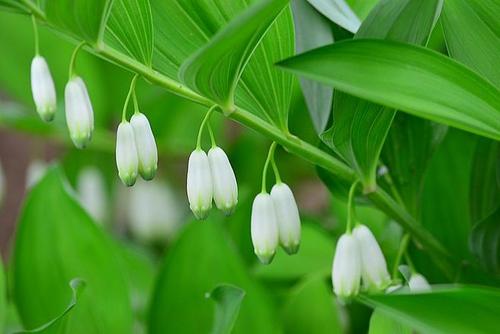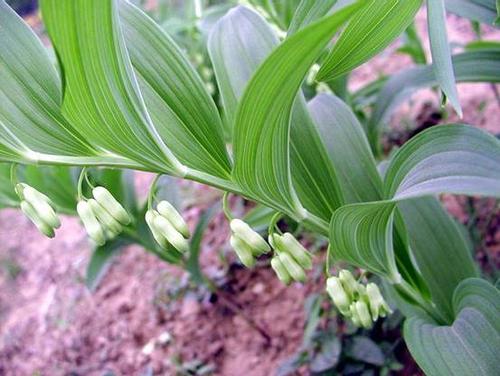Solomons-seal (Polygonatum odoratum) Profile
Written by Maggie
Dec 14 2022

Solomon's-Seal (scientific name: Polygonatum odoratum) is a plant of the genus Odoratum in the pseudo leaf family.
Solomon's Seal Picture

Solomon's Seal Info
| Botanical Name | Polygonatum odoratum |
| Common Names | Solomon's seal |
| Plant Type | Herbaceous perennial |
| Sun | Part shade to full shade |
| Hardiness Zones | 3 to 9 |
| Flower color | White, green, pink |
| Native Area | North America |
| Mature size | 6 inches to 7 feet tall (depending on species) |
Morphological Characteristics of Solomon's-Seal
Stems
The rhizome of Solomon's-Seal is cylindrical, 5-14 mm in diameter. Stem is 20-50 cm tall, with 7 12 leaves.
Leaf
Leaves of Solomon's -seal are alternate, elliptic to ovate-oblong, 5 -- 12 x 3 -- 16 cm, apex acute, grayish below, veins smooth to papillary coarsely above.
Flowers
Inflorescences of Solomon's-Seal with 1- to 4-flowered (up to 8 in cultivation) pedicels (pedicels when single) 1-1.5 cm long, bracteate or lanceolate; Perianth is yellow-green to white, 13-20 mm in length, perianth tube straight, lobes about 3-4 mm in length; Filaments are filiform, subsmooth to papillate, anthers ca. 4 mm; Ovary is 3 -- 4 mm long, style 10 -- 14 mm.
Fruit
The berries of Solomon's-Seal are blue-black, 7-10 mm in diameter, with 7-9 berries.
The Ecological Habits of Solomon-seal
The Ecological Environment
Solomon's-Seal was born in the elevation of 500-3000 meters under the forest or mountain slope, Eurasia temperate regions widely distributed.
The geographical distribution of solomon's-seal
In the wild, Solomon's -seal grows on grassy hillsides or in damp areas between forests. It is found in most provinces of China, including Heilongjiang, Jilin, Liaoning, Hebei, Shanxi, Inner Mongolia, Gansu, Qinghai, Shandong, Henan, Hubei, Hunan, Anhui, Jiangxi, Jiangsu, Taiwan and Fujian. It is also found in Japan.
Growth Habit
Yellow loam or sandy loam with deep, fertile, loose soil layer, leeward to the sun, and convenient irrigation should be selected. Pay attention to crop rotation, and the pH value of 5.5-6 is the most suitable.
Seeds with fertilizer plant row spacing 25 to 30 cm, 10 ~ 15 cm, line 8 ~ 10 cm deep, every 667 square metre 20000 strains, planting depth of 20 cm, sowing will shoot apex slightly tilted upward, in the same direction when seeding after fertilization, compound fertilizer in the middle of the two strains, not hit a kind of stem, in case of burns affect germination, no fertilizer, best with rotten human waste of water spray, above put rotten pig dung, and then cover the soil.
Soil cover requirements: 10 ~ 15cm thick mulch, fallen branches, straw, thatch, corn stalks, etc., covering time for about 6 months, the purpose is to keep the soil loose, moist soil, heat preservation and frost prevention, to prevent Solomon's-Seal exposed and lost fertilizer, cooling and heat, to prevent weed growth, etc.
Biological Physical Property
Solomon's-Seal is suitable for warm and humid climates, like wet environments, cold resistance, in mountainous areas and Pingba can be cultivated. The upper layer of deep, fertile, well drained, slightly acidic sandy loam is suitable for cultivation. Do not plant in clay, humidity is too large. Avoid continuous cropping.
How to Grow and Care for Solomon's-seal
Light
Solomon's seal vegetation is naturally observed developing underneath massive coloration bushes in dappled light. So a perfect planting web page in your backyard has to have partial to full shade. They can tolerate greater solar when grown in cooler climates than they can in hotter climates.
Also Read: 10 Best Ground Cover Plants for Shade in Your Yard
Soil
These flowers like cool soil that’s wealthy in nature and has desirable drainage. A barely acidic soil pH is ideal. To enlarge the richness of your soil, it can be useful to add a layer of compost round your Solomon’s seal every year.
Water
Solomon's seal flora decides upon soil that stays evenly moist however now not soggy. Young plant life must be watered usually to hold constant moisture in the soil. Established vegetation nonetheless decide on to be in soil that is damp to the touch, although they can tolerate quick durations of drought if necessary.
Temperature and humidity
The a number species of Solomon’s seal can develop in USDA hardiness zones three to 9. While they pick cool and shady environments with some humidity, they can correctly develop in warm and dry climates with some help. Make positive the flora have enough soil moisture and shade, as nicely as safety from strong, warm winds. Plus, a layer of mulch round the flora can assist to preserve their roots cool. In the fall, frost will motive the vegetation to start to die lower back to their roots for the winter.
Fertilizer
Because this plant likes to develop in lots of natural matter, combine some compost into the soil of your backyard website online when first planting Solomon's seal to provide it a desirable start. Then, proceed to add a natural fertilizer or compost every year at the beginning of the developing season to supply your plant a boost, in particular if you do not have naturally fertile soil.

Disease & pest control of solomon's-seal
Disease control
Leaf spot
For the fungal disease, mainly damage the leaves. First from the tip of the elliptic or irregular shape, the edge of the purple, brown in the middle of the disease spot, from the disease spot gradually spreads downward, so that the leaves become pale white, withered and die. Began to come on in summer autumn more, the rainy season came on more seriously.
Prevention and control methods:
(1) Timely clean the rural health after harvest, burn the dead branches, diseases and residues, and eliminate the pathogens of overwintering in the rural area;
(2) Pharmaceutical prevention and control in the onset and early onset of 1:1:120 Bordeaux liquid spray, or 50% of the 1000 times the special liquid, every 10 days spray 1 times, 2-3 times in a row.
Root rot
Symptom recognition: the root and stem of the initial stage of disease is light brown round spots, after the disease decompose, tissue discrete, depression, round or oval diameter of 5~10mm, serious disease spots into large blocks, affecting the yield and quality of Solomon's-Seal.The disease in old cultivated areas of Guangdong Province has a tendency of increasing year by year.
Pathogen: Fusarium Solani, Radicola (Mar.) SACC.F. sp., (Wr.) Snyd. Et Hans, belonging to a specific type of the genus Fusarium and the subphylum Semi-known.Mycelium white to lilac, flocculent, more lush.Small conidia are many, colorless monocytes, ovoid to fusiform, 6-15 μm× 2-4 μm in size. The large conidia are fusiform, colorless and slightly curved, with 3 to 5 septum, size 20 to 35μm×2.6 to 4.7μm. Chlamychospores are numerous, solitary or 2 to 3 in succession, spherical, pale yellow in size, 6~11μm×6~9μm.
Pathogenesis: The pathogen overwintered in soil with mycelium and conidia, which belongs to soil-borne root disease.It was an important disease in Solomon's-Seal production.
Pest control
Grubs
Adult grubs appear in the middle of May and are active in the evening. They lay eggs on the unripe manure, and the eggs are scattered in the wetter soil.
Prevention and control methods:
One is to remove weeds in winter, turn over the land and destroy overwintering places.Second, the use of decomposed barnyard manure, compost, reduce adult eggs. Three is to do the bed of 25~30 kilograms of lime per mu, sprinkled on the soil surface after turning into, to kill the larvae.Four is to use 90% crystal trichlorfon 1000~1500 times the irrigation of the soil around the root. Five is the light lures the beetle.
Solomon's-seal species classification
There are more than 60 species within the Polygonatum genus. The species have very similar growing requirements but can range in size, coloring, and other factors. Some popular varieties include:
Polygonatum biflorum: This species grows roughly 1 to 3 feet tall. Its leaves are smooth on both sides, and the plant features white-green flowers.
Polygonatum odoratum var. pluriflorum 'Variegatum': This plant reaches around 2 to 3 feet tall, and its leaves have white edges. The white flowers have a sweet fragrance reminiscent of lilies.
Polygonatum 'Prince Charming': This variety only grows to about a foot tall, but it spreads to around 2 to 3 feet wide. 'Prince Charming' plants tend to bloom at a younger age than many other Solomon's seal plants and feature greenish-white flowers.
Solomon's-seal area of distribution
Solomon's-Seal is made in Heilongjiang, Jilin, Liaoning, Hebei, Shanxi, Inner Mongolia, Gansu, Qinghai, Shandong, Henan, Hubei, Hunan, Anhui, Jiangxi, Jiangsu and Taiwan.
Solomon's-Seal forest or mountain shady slopes, 500-3000 m. The temperate zone of Eurasia is widespread.
Solomon's-seal use
Medical use
In traditional Chinese medicine, the root and stem of Solomon's-seal are used for medicine, which is smooth and sweet in taste. It is a nourishing and strong medicine, generates fluid and quench thirst, and is mainly used for curing fever, Yin injury, deficiency and heat dryness, cough and thirst elimination.
The economic value
Solomon's-Seal has the effect of moistening dryness, clearing heat, stimulating fluid and relieving cough.Used as a tonic medicine, mainly for fever Yin, deficiency, heat and dry cough, heart disease, diabetes, tuberculosis and other diseases, and can be used as advanced nourishing food, delicacies and drinks, with health care effect, is worthy of the vast number of farmers planting.

Latest Updated
- Benefits of Bugleweed - 7 Science-backed Health Benefits
- Bugleweed Dangers & Side Effects - Is It Poisonous?
- How to Plant Evergreen Trees - What You Should Know
- When to Plant Evergreens - Grow Guide for Evergreen Trees
- 12 Wonderful Evergreen Shrubs for Your Garden
- 12 Popular Evergreen Plants with Pictures for Beginners
- When And How To Prune A Lilac Bush Like a Pro
- How to Grow & Care for Lilac Vine (Hardenbergia Violacea)
- Japanese Lilac Tree (Syringa Reticulata) Care & Propagation Guide
- Shumard Oak Pros and Cons - What to Know
Popular Articles
- Winter maintenance of Antirrhinum Majus
- How to Grow Terminalia Mantaly Tree
- How to Grow and Care for Crossostephium Chinense
- How to grow Antirrhinum Majus in spring
- Peristeria Elata (Dove Orchid) Profile: Info & Care Guide
- Underwatered Snake Plant (Sansevieria Trifasciata) - Signs And How To Fix
- How to Care for Brazilian Jasmine Plant (Mandevilla Sanderi)
- How to Grow & Care for Graptopetalum Purple Delight in Summer
- Rosa Chinensis (China Rose): Plant Growing & Care Tips
- How to Care for Baby Sun Rose (Aptenia Cordifolia)